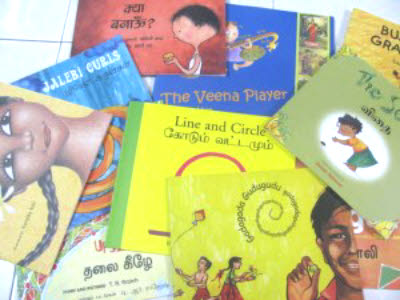Interview by Anupama Krishnakumar
Radhika Menon of Tulika Publishers opens up on the inception of Tulika Publishers, the books they publish, the challenges they face, future plans of Tulika and her thoughts on the Indian children’s publishing industry. Catch Radhika Menon’s interesting response to Anupama Krishnakumar’s questions here.
Radhika Menon is the Managing Editor of Tulika Publishers, an independent children’s publishing house based in Chennai. Tulika has produced over 200 titles, for the age group 0-16 years. They include picture books, bilingual books and folktales, contemporary fiction and non-fiction, and much more. Tulika publishes in English, Hindi, Tamil, Malayalam, Kannada, Telugu, Marathi, Gujarati, and Bangla. To know more about Tulika Publishers and their books, visit http://www.tulikabooks.com
 Tell us a bit about how Tulika Publishers was born. What was the motivation behind setting up a publishing house exclusively for children’s literature?
Tell us a bit about how Tulika Publishers was born. What was the motivation behind setting up a publishing house exclusively for children’s literature?
My interest in children’s books goes back to my teaching days in two very good schools, the J. Krishnamurthi School (KFI) in Chennai and later in Sardar Patel Vidyalaya in Delhi. Both schools didn’t follow the beaten track and had a much more relevant and creative curriculum. There was a lot of emphasis on Indian languages and content when it came to classroom projects, storytelling, drama, music and so on. I had access to great children’s books and some very good western educational magazines and journals. This exposure was an eye opener and changed the way I looked at children’s books. I realized that intrinsic to Indian children’s books was an Indian style of telling, visualizing and illustrating.
Culturally rooted children’s books, even when in English, had to have an Indian sensibility in the use of language, contexts, visuals, and even in the look and feel. The creative challenge of this idea was irresistible and led to Tulika starting 15 years ago as a multilingual children’s publishing house.
What made you decide to publish in not just English but other languages too?
It was very clear in my mind that Indian children’s books by definition could not be just in English! Many of us grew up on imported western children’s books and poor imitations, with some exceptions of Indian children’s books in English. The divide between English and other Indian languages was huge and so if you read in one language you were cut off from the other – in fact you didn’t even respond to the books in another language. This to me as a teacher and parent was unacceptable and went against the values of a plural society.
India is so culturally, socially, economically, politically, linguistically diverse, that there cannot be any one representation of the whole. Doing books in different languages helps us give voice and image to the details of this diversity in a way that publishing in just one language does not. The experience has made it clear to us that our books can and must work for all children, reading in different cultural contexts, within and outside India. The choices in terms of the kind of books we publish are based on this.
Both Sandhya, a long-time friend who joined me as editor, and I, were equally convinced about the need to publish in several languages simultaneously. We started with English, Hindi, Tamil and Malayalam. The first three titles we published were two bilingual picture books, ‘Line and Circle’ and ‘Number Birds’ and a Hindi alphabet book called ‘Ka se kapde kaise’.
What are the most sought after themes as far as children’s books in India are concerned?
At a popular level, the ubiquitous folk tales, stories from the Panchatantra, popular Hindu myths and general knowledge and information books. I don’t think that has changed even today. But this has also to do with the market feeding more and more of these to the exclusion of other kind of books. Our experience has been that contemporary stories are as popular and that attractively produced books have a lot of appeal. Tulika has overturned many preconceived notions about the kind of books children will like and respond to. We have not followed western concepts of content in children’s books for any age group either – both in text and visuals.
Talking of publishing, how do you select the stories that you publish? Can you please share with us some of the most important criteria that you insist a children’s story should satisfy?
There really are no set criteria. Sometimes, it is the strength of the story itself and sometimes it is just an idea. As we do a lot of picture books, we select stories that open up exciting visual possibilities. Sometimes we get manuscripts that are very well written and there is little we need to do with it but sometimes they have to be completely rewritten for which we work closely with the authors. We also keep in mind the suitability for translating the story though we do make exceptions and go with just one language – when an idea can work just in that language, like verse for example.
What do you feel are the challenges that children’s publishing is facing in our country?
The biggest challenge is the quality of content. In children’s publishing in India, too much is happening too fast after a very late start. Specialised children’s publishing is about 15 years old and Tulika is one of the first in the field. But with more players coming in the field, especially the big Indian and multinational players, the scene has changed drastically. I use the word ‘drastically’ deliberately – when growth is so fast-tracked, it gives rise to unhealthy trends which ultimately affect the quality of content.
One of the main problems is a lack of expertise in children’s publishing – in editing, visualising, design, marketing, distributing, retail selling – in every related field. There is a lack of the kind of expertise that is always fostered by traditional publishing. But in the current publishing scenario, there is the pressure of big publishing to produce more and more books without any editorial vision and to sell more and more to meet the targets of big business. The result is inevitably mediocre books. Of course, when so much is published, there are some books by talented writers and illustrators that get published but they always fall short of being really good because of poor publishing standards.
Another real problem I see is the market taking over and setting the standards of what a good book is, through awards and high profile events, and publicity, without any knowledge of what they are promoting. Similarly, there is this whole emphasis on events by big bookstores and even schools that are done primarily to get media coverage. The events are to entertain children, so it is more about storytelling performances and ‘activities’. As a result, the content of books is of no consequence. What is the message then to children who we nag endlessly about not reading enough?
One can see the problems of this fast track growth in a place like Singapore where the effects get concentrated because of the small size of the market. The government is giving a lot of support in the form of subsidies for local books by Singapore authors and illustrators and prestigious awards. But the books displayed prominently in bookstores lack character or depth. They are didactic, patronizing and culturally ambivalent.
To develop a distinctive body of contemporary children literature, we have to explore new directions – as in adult literature – and not rest content with being imitative or prescriptive. And I am not at all sure if pressure of fast growth is going to do this. On a positive note, we do have the advantage of a vast readership with different needs and requirements, which go against globalised trends, and a very unorganised book market, despite the best efforts to streamline it. These conditions do offer the space for excellence to those committed to it.
What are some challenges that Tulika has specifically faced?
Translating in nine different languages is a constant challenge editorially – each translation throwing up a new one! Marketing and distributing the books in nine languages is the huge bottleneck we face especially in the mainstream market. The big chain bookstores present the biggest problem – the bigger they are the worse the problems. This is because of their lack of knowledge about books, not having efficient systems of reorders and the pressures of having to stock large spaces and sell anything – as long as money comes in!
The small, independent bookstores do very well in contrast, as they focus on books – they know their books and they know their customers. As a result, retail sales are a small percentage of our overall sales. We have established alternate distribution networks especially for books in languages. Our website sales have picked up considerably and we are able to reach customers both outside and within India. It is quite common to see Tulika’s books in a remote village library or a school in the US or UK but not in the big chain stores in metros.
What do you think is in store for the industry itself going forward? For instance, do you see more competition i.e. more players, coming into the picture? Do you see any bigger challenges?
There are more and more new players and healthy competition is not a bad thing at all. The bigger challenge is what everyone in book publishing is talking about – the digital revolution of publishing. That it will impact children’s book publishing is certain but may be not to the extent that it will in other areas of publishing. Some trends are welcome. For instance, the net has transformed book buying. For Tulika, this has been a very posiitve development. We can reach customers directly and vice-versa without being dependent solely and helplessly on bookstores and trade distribution.
My own view is that children’s book publishing and the market for children’s books is just growing – in one sense we are in the first phase of children’s publishing. So the digital phase will be slow to catch up though there are already companies focusing on digital content for children. It will grow simultaneously but I don’t think it will overtake the book market. It will be like the children’s CD and DVD market which is strong. But, the market for our books for instance, has grown healthily and doesn’t show any effects of being adversely affected. The worry is whether quality will be further compromised; while children’s CD, DVD, television and animation content is growing, the content remains dismally mediocre. So too I fear will digital content. We don’t have a tradition of excellence in anything to do with children unfortunately – it has always been given low priority. The pressures of the market are hardly going to foster quality content.
On the other hand, the lack of quality content may see good books being adapted and transformed to other media. This has been Tulika’s experience. The books are being adapted for animation, children’s theatre, audio books and digital formats. Three of our books are on the iPad as apps and ebooks not just in English but in Hindi and Tamil as well. Book-based merchandise will soon be launched. Thus the content of our books, both text and visuals, is slowly and steadily impacting the cultural milieu of the child in significant ways. This in the Indian context is a very positive and significant development.
What can we look forward to from Tulika Publishers? What are your future plans?
We will continue to do a diverse range of books, and will explore other genres, build up a strong non-fiction list, continue to discover new talent in writing, illustrating and translating, increase the reach of our books in the different languages not just in India but outside as well. We will also continue to partner organizations for using the content of our books in different media and in different forms and increasing their reach.






